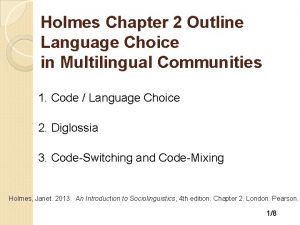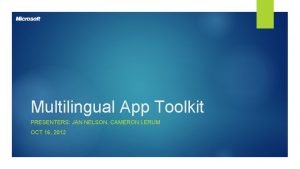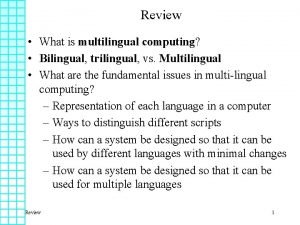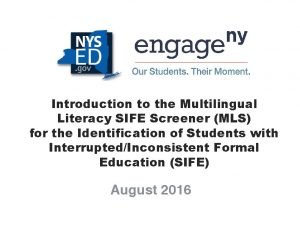Holmes Chapter 2 Outline Language Choice in Multilingual








- Slides: 8

Holmes Chapter 2 Outline Language Choice in Multilingual Communities 1. Code / Language Choice 2. Diglossia 3. Code-Switching and Code-Mixing Holmes, Janet. 2013. An Introduction to Sociolinguistics, 4 th edition. Chapter 2. London: Pearson. 1/8

Domains of Language Use Participants Setting Topic Holmes, Janet. 2013. An Introduction to Sociolinguistics, 4 th edition. London: Pearson, p. 21. 2/8

Language Choice Decision Tree Fasold, Ralph. 1984. The Sociolinguistics of Society. Oxford: Blackwell Publishers, p. 201. 3/8

Drawback of the Domain Approach “The domain-based approach allows for only one choice of language per domain, namely the language used most of the time in that domain. Clearly more than one language may occur in any domain. Different people may use different languages in the same domain. ” Holmes, Janet. 2013. An Introduction to Sociolinguistics, 4 th edition. London: Pearson, p. 47. 4/8

Diglossia—Narrow Definition 1. Two distinct varieties of the same language are used in the community. (One is regarded as High, the other as Low. ) 2. Each variety is used for quite distinct functions; H and L complement each other. 3. No one uses the H variety in everyday conversation. Holmes, Janet. 2013. An Introduction to Sociolinguistics, 4 th edition. London: Pearson, p. 27. 5/8: 3

Factors Affecting Code-Switching Situational Switching Topic For Affective Functions Metaphorical Switching Holmes, Janet. 2013. An Introduction to Sociolinguistics, 4 th edition. London: Pearson, pp. 34 -43. 6/8: 4

Thesis Topic: Lexical Borrowing in Chinese 1. How much borrowing is there in Chinese (or Mandarin)? (e. g. , from English) 2. What kinds of borrowing? 3. What do the borrowed words look like after borrowing? Has the pronunciation changed? Has the meaning changed? 4. Are people aware that a word is borrowed? 5. Is borrowing necessary? 7/8

Questions for Discussion 1. Describe your Linguistic Repertoire. (List format is OK. ) 2. List the varieties you used yesterday: give domain, participants, setting (as appropriate). 3. Think back to the last (most recent) time you code-switched. What kind of switching did you do? Why? 8/8















